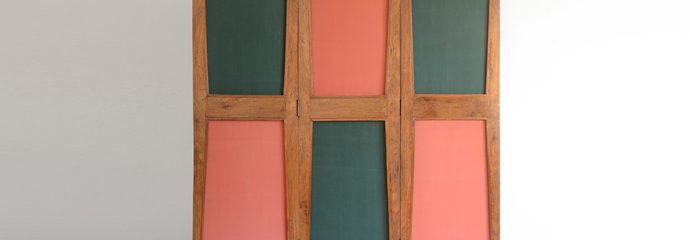JP-Scal-451
JP-Scal-451
Daybed produced by Les Ateliers Jean Prouvé, Nancy, France, circa 1953
Price:
on request
Dimensions:
61 x 195 x 91 cm
24 x 76.8 x 35.8 in
Materials:
Mahagony, steel, upholstery
Daybed produced by Les Ateliers Jean Prouvé, Nancy, France, circa 1953
on request
61 x 195 x 91 cm
24 x 76.8 x 35.8 in
Mahagony, steel, upholstery
A lounge chair that turns into a chaise, made by Studio D’arte Palma, ca. 1955 Brazil.
on request
90 x 81 x 80 (140) cm
35.4 x 31.9 x 31.5 (55.1) in
Jacaranda solid wood, fabric
single bed without headrest, ca. 1955-1956
on request
46 x 200 x 83 cm
18.1 x 78.7 x 32.7 in
Teak, fabric
Collapsible single bed without headrest, ca. 1955-1956
on request
46 x 200 x 83 cm
18.1 x 78.7 x 32.7 in
Teak, fabric
Rare and important witness box of the High Court of Chandigarh, 1955
on request
117 x 144 x 119 cm
46 x 56.7 x 46.8 in
Teak massiv and veneer
Wall lights, set of ten enamelles steel by Charlotte Perriand. For Gallery Steph Simon. Signed with Made in France Classe 1, ca. 1950
on request
130mm x 180mm x 70mm
Enameled steel
Big box of massive cane with cane, used in M.L.A flats, ca. 1956
on request
480mm x 710mm x 460mm
Solid teak, cane
Ventilator shutter, as sunprotection and to bring air into the space. Designed by Le Corbusier. Done in folded, riveted sheets aluminium. Profiled in the shape of an aeroplanes wing. With steel pivots at the end.Ca. 1956-1957.
on request
2970mm x 440mm x 60mm
Aluminium
Daybed with compass legs, 1957-1958. Used in administration buildings and private homes
on request
35 x 195 x 80 cm
13.75 x 76.75 x 31.50 in
Solid teak and any upholstery you like
Residential building, Chandigarh.
Eric Touchaleaume and Gérald Moreau, Le Corbusier, Pierre Jeanneret: L’Aventure Indienne, Paris, 2010, p. 591.



Screen, 1957- 1958, with three double sided panels
on request
172 x 151 x 5 cm
67.7 x 59.5 x 2 in
Solid teak, dark green and red cotton
screen and a room divider made of teak and cotton. A rare screen from the collection of Chandigarh. A piece of furniture of great importance. It is a thing of everyday life. At auctions sold for a lot of money. It is as good as ever. A history of India shows an industrialization affecting the Punjab and North India. The Mogularchitecture and modern India met here and created a new capital. Much water, politics and creativity also made the city an architectural masterpiece. Nehru created a capitol and a culture of museums. An art collection was here and the rare gold and silver were here. Metals and concrete created a place of encounter. So was the pottery and the craft, where teak and metal came into being. Pipe braid and the magic of Le Corbusier and Pierre Jeanneret. The villa in Ahmedabad and the paintings were significant. In the period from 1950 to 1960 visions were important and life in the countryside was hard. The Romanticism of European Modernism has created modernist buildings of stone and clay. Fire and water were elements of peace, where the Parliament and the citizens wanted an architecture and its furnishing. The culture is something important.
The Pierre Jeanneret divider is accessory furniture for homes. It serves as a screen for bedroom spaces. Jeanneret’s furniture is unique. This makes this divider unique and fascinating. Unlike other screens, this divider has an innovative design. Pierre Jeanneret was a designer who believed in innovation. His artwork gained him immense success and fame. The real estate in Chandigarh is the work of Jeanneret and Corbusier. The cousins developed the city. They brought the concept of Brutalism in architecture.
The designer was a Swiss architect and constructed various buildings across the world. He designed concrete architecture in India. Pierre Jeanneret was a visionary of modern architecture. This is seen in his designs. He brought the concept of Brutalism in India. Brutalism is a type of architecture of the 20th century. It started off in the 1950s. Jeanneret specialized in furniture. His 20th-century design of this screen is outstanding. The Pierre Jeanneret divider is an antique of the 1950s. The divider is available in museums and galleries. There are design auctions for the sale of this furniture.
Pierre Jeanneret used lighter materials in his designs. The lighter materials consisted of wood, cane, cotton, etc. This screen has a composition of solid teak wood and cotton. The teak wood is a core element in Jeanneret’s designs. This is because teak wood makes the furniture strong. Teak wood protects the screen from infestations. This makes the Pierre Jeanneret divider durable. The designer used cotton for the screen. Red and dark green cotton is used. Cotton is a versatile and reliable material. These materials increase the life of the furniture. This Pierre Jeanneret divider is ideal for bedroom spaces. Those who love vintage screens should buy this.
The designer houses by Pierre Jeanneret have this screen. Pierre Jeanneret divider is a beautiful masterpiece by the designer. The screen is structurally strong furniture. The furniture has a unique feature. This feature is the full extension of the screen. The fully extended screen facilitates covering a larger surface area. The divider has a heightened appearance. It stands sturdy and strong. There are proportionate patches of red and dark green cotton. This design makes the furniture look unique. The Pierre Jeanneret divider has three double-sided panels. These panels have equal sizes. This beautiful and antique furniture is perfect for all the art lovers.
